The August 1st, 1927 founding of the People’s Liberation Army (PLA) is an anniversary marked each year by a host of commemorative events. Because the People’s Liberation Army is one of the most important arts organizations in the country, most of the celebratory activities are cultural.
Events held in Beijing this year included several performances of the model revolutionary ballet “The Red Detachment of Women;” an opera (based on an old movie) called “The Eternal Radio Signal” (which was about as good as it sounds); and a major art exhibition at the National Art Museum of China.
Sheila recently wrote about the exhibition – the biggest military-themed art expo ever held in China – in the International Herald Tribune, in an article entitled “Chinese Army Exposes Its Artistic Side.”
In this posting, we have included several interesting images that did not get included in the article. The first painting – “Sewing the Flag on the Eve of Liberation” – at first glance looks derivative. (As one friend put it, “Betsy Wang!”) In fact, the scene is inspired by the story of “Jiang Jie,” or Sister Jiang, a renowned revolutionary heroine – supposedly based on a real martyr – who is the subject of a novel, a stage drama, an opera, and a movie. In this painting, the imprisoned Jiang and her Communist sisters are cheerfully embroidering golden stars on a red bed quilt to make a flag that will mark the founding of the People’s Republic. Those who know the story will be aware that execution by the guns of the KMT awaits the glowing Sister Jiang, who is symbolic of selfless dedication to the Communist Party.
The next painting, “Xibaipo – 1949” shows Mao Zedong seated in a shaft of sunlight as Liu Shaoqi lectures the troops. Xibaipo is the village in Hebei from which Communist Party and the People’s Liberation Army conducted the last stages of the revolution from May 1948 to March 1949. When they left Xibaipo, it was to March to Beijing. If you look at the walls, you will see that they are hung with CCP flags; the two framed portraits on the wall are of “Zhu-Mao,” that is Zhu De and Mao Zedong. If you look carefully, you can see a young Deng Xiaoping in the audience – and probably many other future leaders, too. The books lying on tables may be copies of the “Chinese Land Law;’ a National Land Law Conference was held in Xibaipo and chaired by Liu Shaoqi – this is probably what he is lecturing on. The land law, which began to be propagated as early as 1947, made 100 million peasants owners of their own land and bought their support for the Party.
The first painting below – “Nan Sha Sky Shower” – was done by the curator of the exhibition, Li Xiang. The soldiers, he explained, are bathing in the rain after being stationed on the Nan Sha Islands (known elsewhere as the Spratleys). It was dry and there was no fresh water, so they are eager to take advantage of the downpour. Mr. Li – who himself visited the Nan Sha to “experience life” there – pointed out the plant strategically placed to block one soldier’s private parts. The exhibition featured paintings of all the contested islands in the South China Seas.
The next image – “In the Interest of the People” – is a detail of an astonishing woodblock print by Dai Daquan and He Fenglin. It shows Mao Zedong carrying a coffin – the one and only time he ever did this. Zhu De is also a pallbearer. The coffin holds the body of Zhang Hao, a Cominterm representative who was also a nephew of Lin Biao. Unfortunately, sites mentioning Lin – Mao’s designated successor, who allegedly tried to assassinate him in 1972 and died in a plane crash while fleeing to the USSR – are blocked in China so we can’t tell you any more about Zhang. The sea of mourners you see surrounding the coffin carry banners or floral arrangements that contain the Chinese word dian, which means to mourn or grieve.
The last image comes from a series of paintings – the guns are pointing at the viewers, and the PLA is “Ready!”

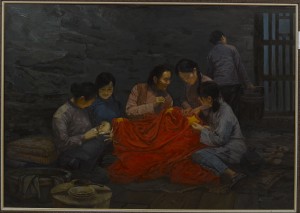
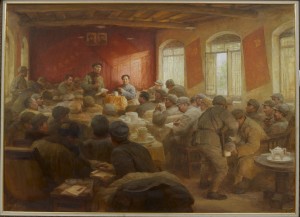
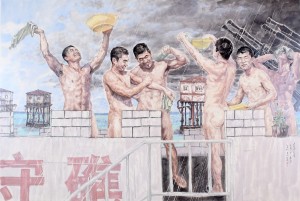
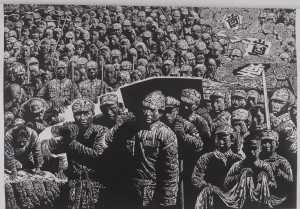
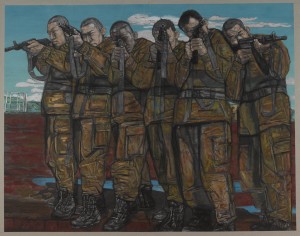
Leave a Reply